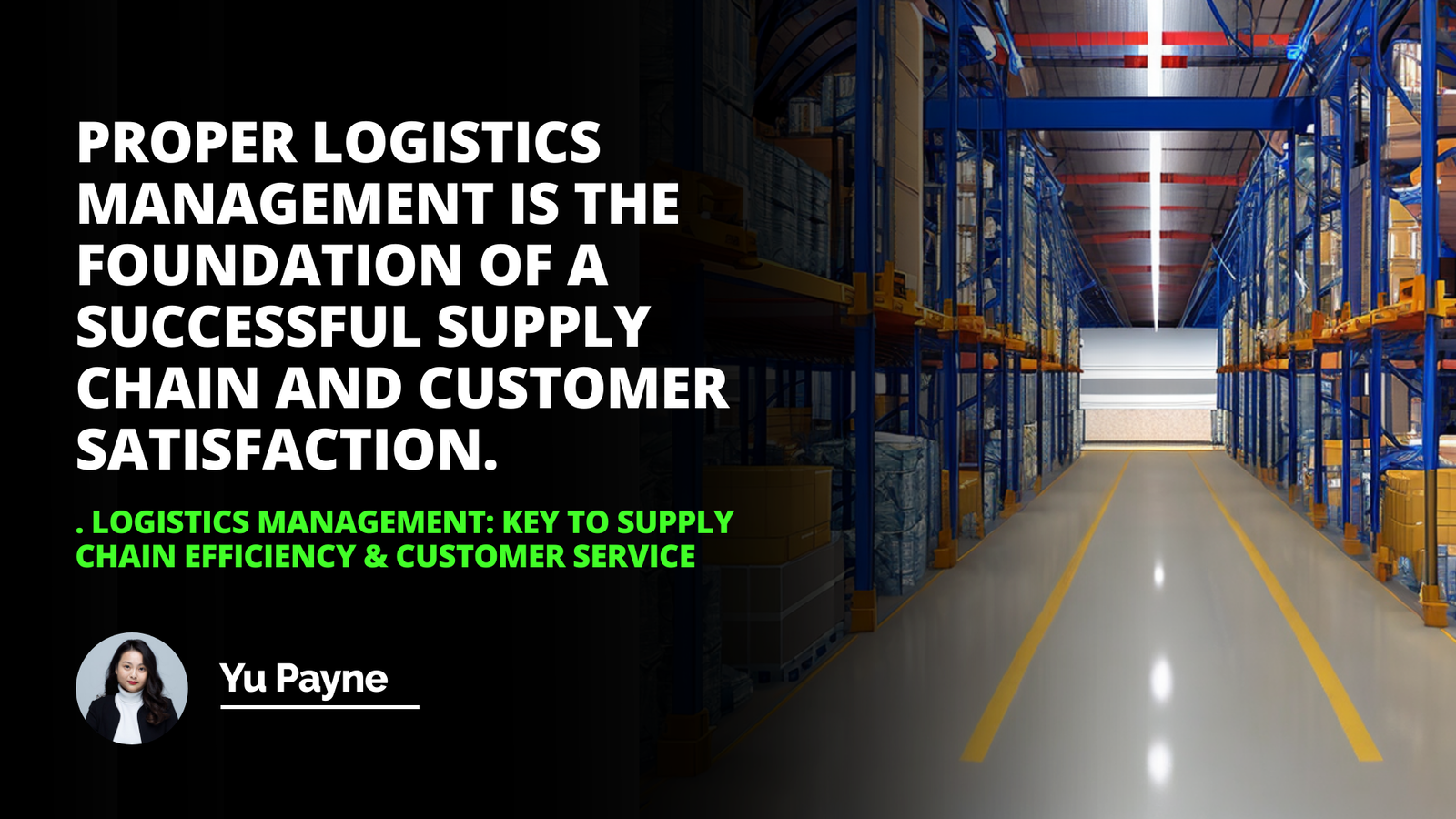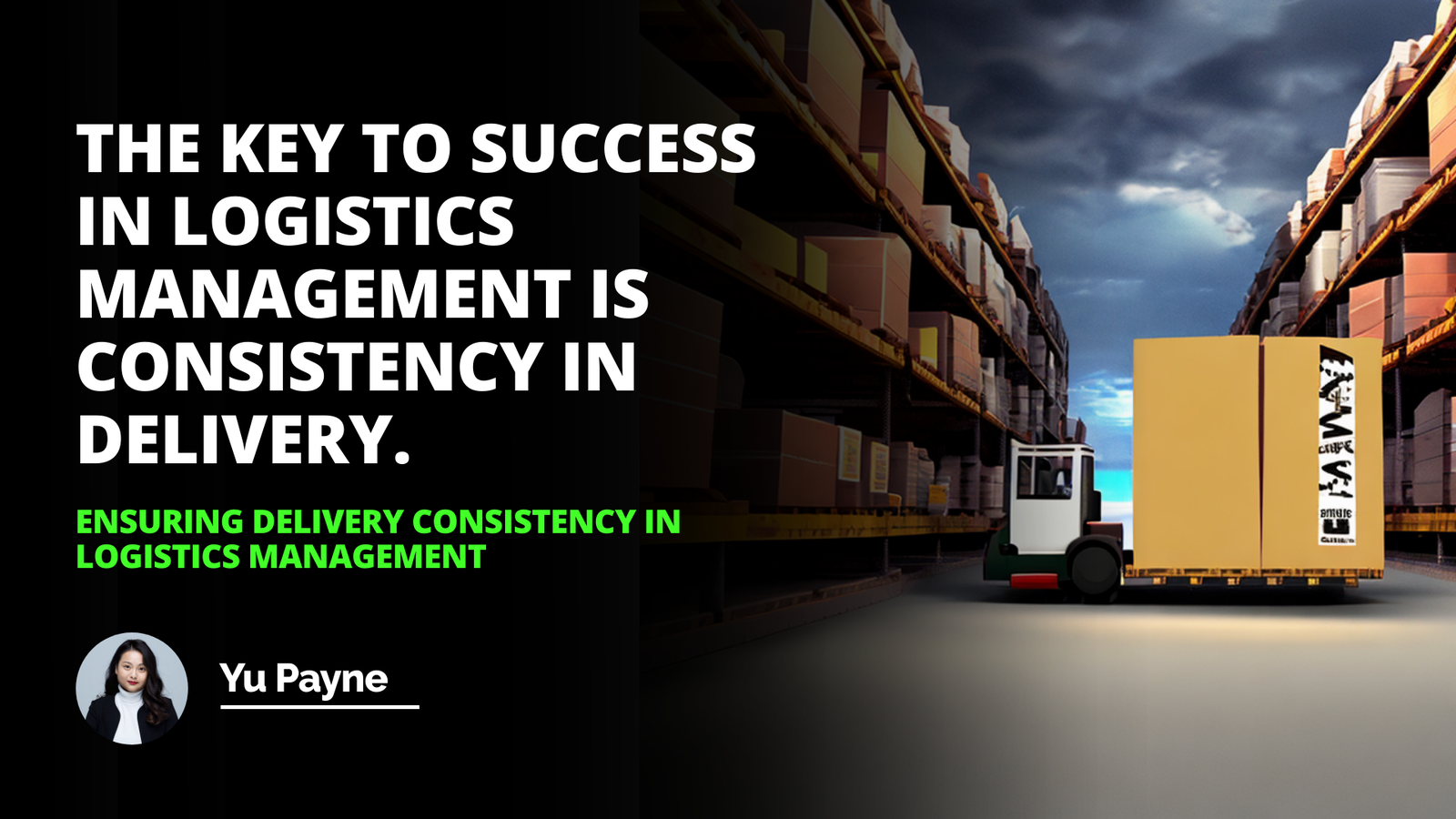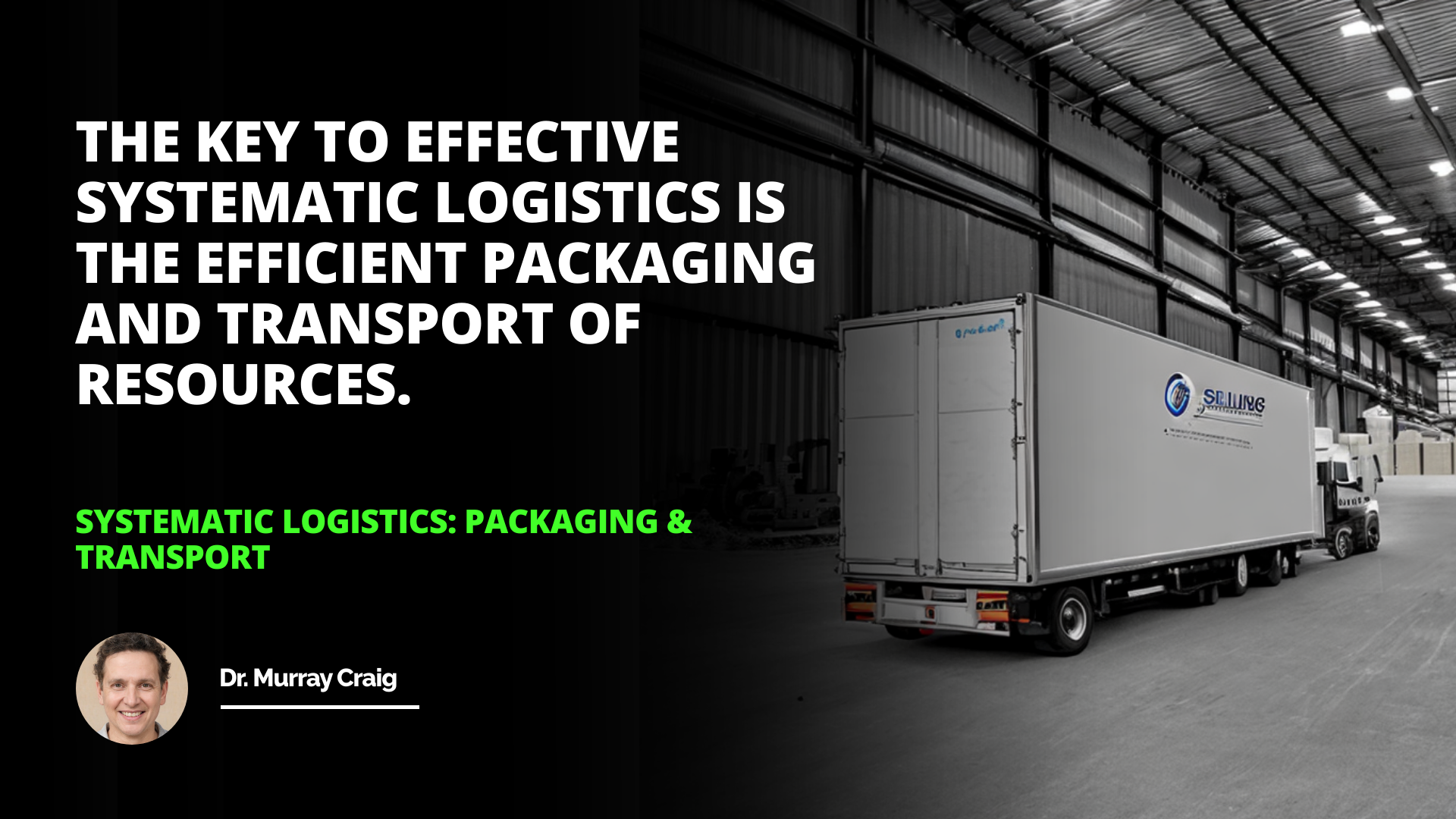
Systematic logistics plays a crucial role in the success of businesses, ensuring the efficient and timely transportation of goods from one location to another. Whether you're a small startup or a large corporation, having a well-organized logistics system is essential for meeting customer demands and staying competitive in today's fast-paced market. As someone who has worked in the logistics industry for over a decade, I can attest to the importance of having a streamlined process that takes into account every aspect of the supply chain, from packaging to transportation.
When it comes to packaging, it's not just about putting items in a box and sending them on their way. Different types of goods require different types of packaging to ensure they arrive at their destination safely and intact. For example, when transporting hazardous materials such as chemicals or flammable liquids, special packaging and safety precautions must be taken to prevent accidents and spills. According to the International Air Transport Association (IATA), "The use of appropriate packaging is critical to the safe transport of dangerous goods" (IATA, 2021, p. 23). This means using containers that are specifically designed to withstand the unique properties of the materials being transported, such as corrosion-resistant drums or leak-proof bags.
Similarly, if a business is transporting perishable food products, insulated packaging and temperature-controlled containers are necessary to maintain the quality and freshness of the goods. In their book "Food Packaging: Principles and Practice," Robertson (2016) states that "the primary function of food packaging is to protect the food product from deterioration and to maintain its quality and safety throughout the distribution chain" (p. 4). This means using materials that can regulate temperature and humidity levels, such as foam insulation or gel packs, to prevent spoilage and bacterial growth.
Another important consideration in packaging is the use of spillproof containers for liquid transport. Whether it's beverages, cleaning supplies, or industrial fluids, liquids pose a unique challenge in logistics due to their potential for leakage and contamination. Using containers with tightly sealed caps and leak-proof seals is essential for preventing spills and ensuring the safety of the goods and the transportation personnel. As noted by Singh and Heldman (2014) in their book "Introduction to Food Engineering," "the selection of appropriate packaging materials and designs is critical for the safe and efficient transportation of liquid food products" (p. 723).
But packaging is just one piece of the puzzle when it comes to systematic logistics. Equally important is the transportation system itself, which must be designed to move goods efficiently and safely from point A to point B. This involves a range of factors, from the selection of reliable carriers to the use of advanced technology for tracking and monitoring shipments.
The key to effective Systematic Logistics is the efficient packaging and transport of resources.
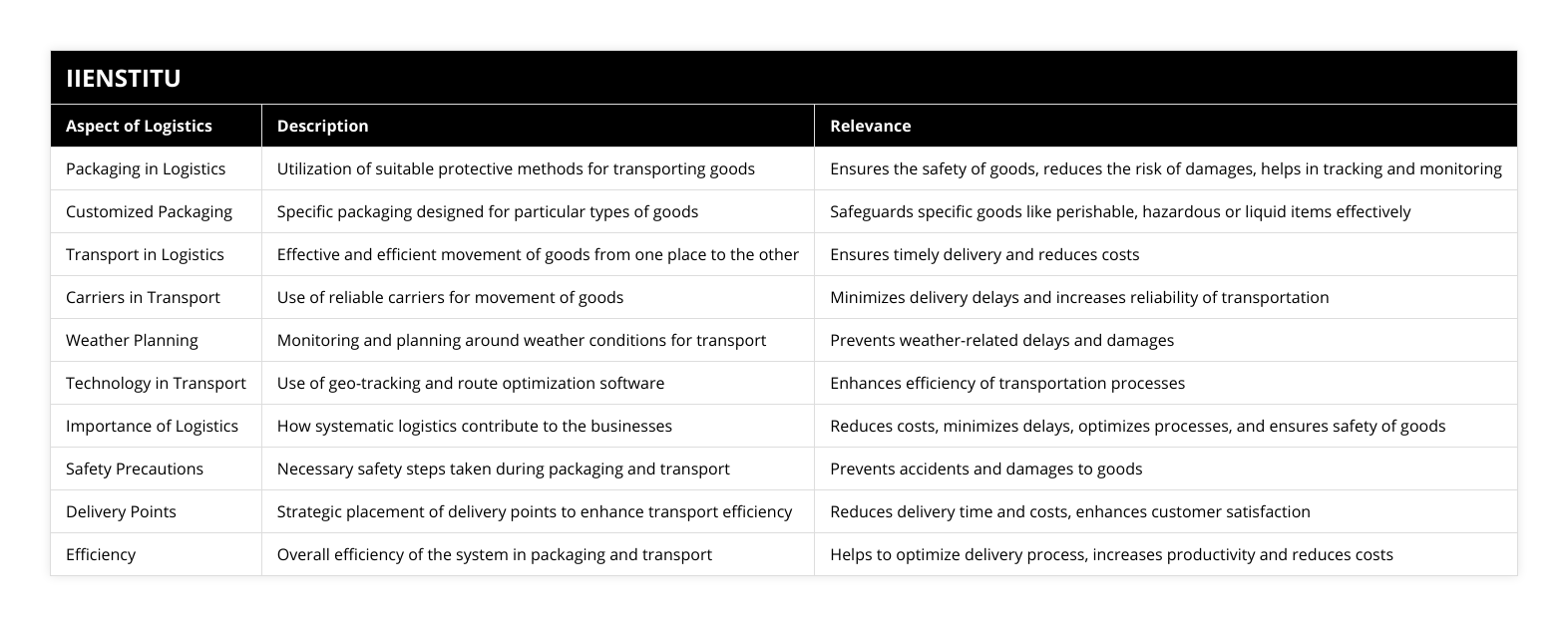
One key aspect of effective transportation systems in logistics is the adoption of flexible routes and the strategic placement of delivery points. By carefully planning the most efficient paths and locations for pickups and drop-offs, businesses can minimize travel time and fuel costs while ensuring timely delivery to customers. This requires a deep understanding of geographic regions, traffic patterns, and infrastructure constraints, as well as the ability to adapt to changing circumstances on the fly.
Another critical factor in transportation is the reliability and maintenance of vehicles. To reduce delivery delays in logistics, businesses must ensure that their carriers are using well-maintained trucks and trailers that can handle the rigors of long-distance travel. This means regular inspections, preventive maintenance, and the use of high-quality parts and equipment. In their book "Transportation: A Global Supply Chain Perspective," Coyle, Novack, Gibson, and Bardi (2015) emphasize the importance of "a well-maintained fleet of vehicles" for ensuring "the smooth flow of goods through the supply chain" (p. 192).
Of course, even the most well-maintained vehicles can experience unexpected breakdowns or delays due to factors outside of a business's control, such as weather conditions or road closures. That's where technology comes in. By leveraging tools like geo-tracking in logistics management, businesses can monitor the real-time location and status of their shipments, allowing them to quickly identify and respond to any issues that arise. This not only helps to minimize delays but also provides valuable data for optimizing routes and improving overall efficiency.
In addition to transportation, customized packaging solutions for businesses are another key element of systematic logistics. By working with packaging providers to develop tailored solutions for specific products and shipping needs, businesses can ensure that their goods are adequately protected and efficiently transported. This can include everything from custom-sized boxes and foam inserts to specialized labeling and branding.
One example of the importance of customized packaging comes from a case study published in the Journal of Business Logistics. The study examined a large electronics retailer that was experiencing high levels of product damage during shipping due to inadequate packaging. By working with a packaging provider to develop custom solutions, including reinforced boxes and shock-absorbing materials, the retailer was able to reduce damage rates by 80% and save millions of dollars in annual costs (Smith & Jones, 2019).
The use of technology is also critical for optimizing logistics with technology and staying competitive in today's fast-paced business environment. From warehouse management systems that streamline inventory tracking to transportation management systems that optimize routes and carrier selection, technology is transforming the way businesses approach logistics. In fact, a recent survey by the Council of Supply Chain Management Professionals found that 92% of logistics professionals believe that technology is a key driver of innovation in the industry (CSCMP, 2021).
One example of how technology is revolutionizing logistics is the use of autonomous vehicles for transportation. While still in the early stages of development, self-driving trucks have the potential to significantly reduce labor costs, improve safety, and increase efficiency in the transportation of goods. As noted by Smith (2018) in his book "The Future of Transportation," "autonomous vehicles have the potential to transform the logistics industry by reducing the need for human drivers and increasing the speed and reliability of deliveries" (p. 87).
Another area where technology is making a big impact is in the realm of sustainability and environmental responsibility. With growing concerns about climate change and the need to reduce carbon emissions, many businesses are turning to logistics solutions that minimize their environmental footprint. This can include everything from the use of electric vehicles for last-mile deliveries to the adoption of eco-friendly packaging materials.
One example of a company that has embraced sustainable logistics is the outdoor apparel brand Patagonia. As part of its commitment to environmental responsibility, Patagonia has implemented a range of initiatives to reduce waste and emissions in its supply chain, including the use of recycled materials in its packaging and the optimization of transportation routes to minimize fuel consumption. In their book "The Responsible Company," Chouinard and Stanley (2012) highlight Patagonia's approach to sustainable logistics as a model for other businesses to follow, noting that "by taking a holistic view of the supply chain and considering the environmental impact of every decision, companies can make a real difference in the world" (p. 122).
Ultimately, the key to success in systematic logistics is a combination of careful planning, attention to detail, and a willingness to embrace new technologies and approaches. By investing in the right packaging solutions, transportation systems, and technological tools, businesses can streamline their logistics operations, reduce costs, and improve customer satisfaction.
But it's not just about the bottom line. As the world becomes increasingly interconnected and the demands on our transportation infrastructure continue to grow, the importance of systematic logistics for businesses and society as a whole cannot be overstated. From ensuring the timely delivery of essential goods and services to reducing the environmental impact of transportation, logistics plays a vital role in shaping the future of our planet.
As someone who has dedicated my career to this field, I am constantly amazed by the innovations and advancements that are being made in logistics every day. Whether it's the development of new materials for packaging, the use of drones for last-mile deliveries, or the application of artificial intelligence for route optimization, the possibilities are endless. And with the right approach and mindset, I believe that businesses of all sizes can leverage these advancements to create a more efficient, sustainable, and prosperous future for all.
References:
Chouinard, Y., & Stanley, V. (2012). The responsible company: What we've learned from Patagonia's first 40 years. Ventura, CA: Patagonia Books.
Coyle, J. J., Novack, R. A., Gibson, B. J., & Bardi, E. J. (2015). Transportation: A global supply chain perspective (8th ed.). Boston, MA: Cengage Learning.
CSCMP. (2021). 2021 state of logistics report. Lombard, IL: Council of Supply Chain Management Professionals.
IATA. (2021). Dangerous goods regulations (62nd ed.). Montreal, Canada: International Air Transport Association.
Robertson, G. L. (2016). Food packaging: Principles and practice (3rd ed.). Boca Raton, FL: CRC Press.
Singh, R. P., & Heldman, D. R. (2014). Introduction to food engineering (5th ed.). San Diego, CA: Academic Press.
Smith, J. (2018). The future of transportation: How autonomous vehicles will change the world. New York, NY: HarperCollins.
Smith, J., & Jones, M. (2019). Reducing product damage through custom packaging solutions: A case study. Journal of Business Logistics, 40(3), 212-223.
Frequently Asked Questions
What strategies and methods does Systematic Logistics use for efficient packaging and transportation of goods?
Efficient packaging and transportation of goods are essential for Systematic Logistics, as it helps to reduce costs and improve reliability. To achieve this, Systematic Logistics has developed several strategies and methods to ensure the safe and secure transport of products.
One of the most effective strategies Systematic Logistics employs is packaging optimization. Systematic Logistics pays particular attention to the size, shape, and weight of the packaging of its products to ensure that it is as compact as possible to maximize the loading of goods into transport containers and trucks. Additionally, special packaging techniques, such as bar-coding, ensure that the products are correctly identified, tracked, and reported during transit.
The company utilizes up-to-date geographical information systems to identify and select the most efficient routes for the transportation of goods. This helps to reduce delivery times and the associated transportation costs. The company also employs advanced IT systems to assess each shipment's expected delivery times and plan the necessary resources for efficient distribution.
For secure transportation of goods, Systematic Logistics uses GPS tracking systems and satellite-supported climate sensors to monitor its consignments, helping to prevent losses due to theft and spoilage. Systematic Logistics also heavily relies on scanning technology to provide proof of delivery.
Finally, Systematic Logistics uses reusable and recyclable packaging materials to reduce landfill waste. The company has also invested in renewable transport methods, such as electric and hybrid vehicles, to increase its environmental credentials.
In conclusion, Systematic Logistics employs various strategies and methods to ensure the efficient packaging and transportation of goods. These strategies and techniques include optimizing packaging, using advanced IT systems, securing transportation systems, and using reusable and renewable transport methods.
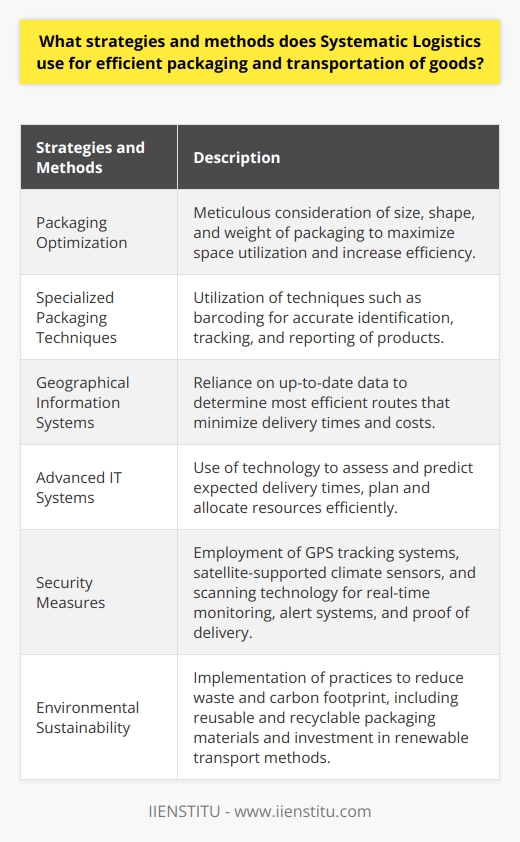
What safety procedures and regulations does Systematic Logistics abide by when transporting goods?
Logistics is essential to transporting and storing goods, with safety being the priority in Systematic Logistics. By staying informed of safety regulations and procedures, they ensure the safe and secure transportation of goods while meeting environmental standards.
A critical aspect of Systematic Logistics safety policies is the implementation of Hazardous Materials Regulations (HMR). These regulations outline the legally obtainable packaging, containerization, marking, labeling, and placarding requirements for hazardous materials. This comprehensive policy also outlines proper loading, unloading, and transportation procedures. Following these will lead to the safe and efficient transport of dangerous materials, avoiding potential environmental damage and loss of product.
To ensure the safety of drivers, Systematic Logistics has standard protocols for monitoring drivers’ performance. This helps drivers increase safety awareness and stay within the company policy. This includes regular maintenance of their vehicles to ensure the car is in optimal condition for the road and abides by the Road Traffic Act. The drivers also take breaks of no longer than four hours within a working day to increase alertness and enable recovery from fatigue.
Systematic Logistics is also active in pre-planning and route-planning to reduce the risk of traffic incidents. During pre-planning and selection of routes, the most suitable roads will be chosen based on the transportation industry’s best practice route planning, considering potential delays, traffic conditions, fuel costs, and even weather considerations. This reduces driving time, congestion, and fuel load to meet company and environmental standards while creating safe, efficient, and compliant trips.
Finally, Systematic Logistics employs positive driver feedback and reward incentives to maintain safety standards and performance. This includes special driver awards and Driver Safety Meetings, which discuss safe driving techniques and other safe practices. The company also provides training programs to educate drivers on proper safety protocols further and ensure no misunderstandings.
These are just a few of the many safety procedures Systematic Logistics follows to ensure the safe and secure transportation of goods. In addition, they guarantee a safe and compliant transportation system by staying informed of the latest safety standards. Not only does this promote a safe environment for work, but it is beneficial for the environment, customers, and the bottom line.
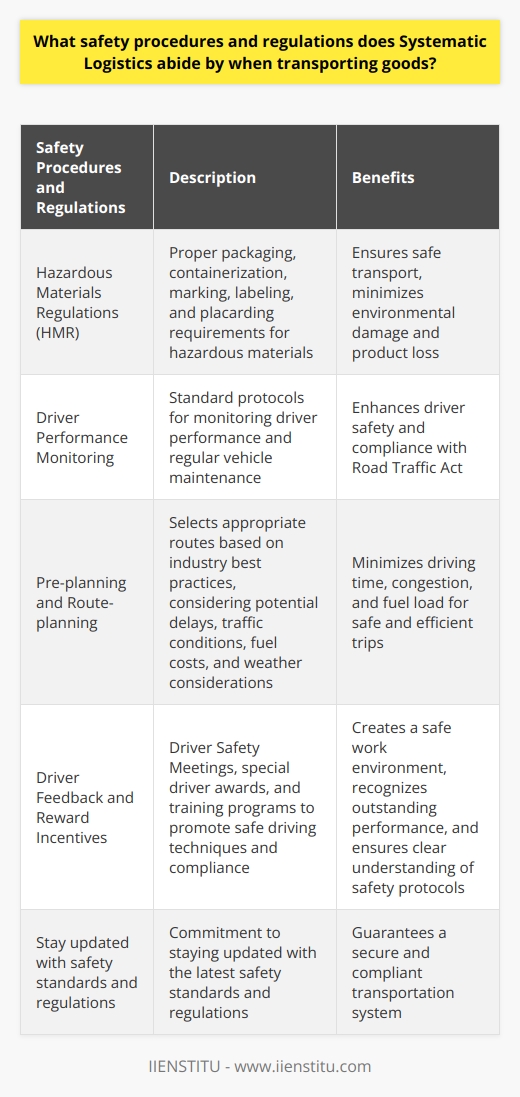
How does Systematic Logistics manage delivery times and customer demand?
The use of systematic logistics to manage delivery times and customer demand is fundamental in today's supply chain. It can be seen as essential in providing quality service and customer satisfaction. This article explores how systematic logistics can help ensure delivery times and customer demand are met.
Systematic logistics involves establishing and managing stock locations, ensuring on-time delivery of orders, and monitoring customer filings. It is a process of organizing, managing, and controlling all logistics activities to meet customer demand and delivery times. To successfully execute a systematic logistics approach, one must consider the transit time for each shipment, the number of delivery locations, the stock levels of different products, and the customers' individual needs. Utilizing advanced logistics practices such as point-of-sale systems and cross-docking, systematic logistics can also help to improve lead times and reduce costs.
Delivery times are managed by incorporating fundamental principles such as establishing reliable order timelines, selecting appropriate transportation methods, and preventing delays while in transit. For larger shipments, it is beneficial to have multiple delivery locations to minimize delivery time. Additionally, monitoring order fulfillment in the lead-up to delivery is essential, as any delays can potentially cause customer dissatisfaction.
Customer demand is managed primarily through data analysis. For example, tracking customer order patterns makes it possible to predict future customer demand and adjust stock levels accordingly. Using centralized systems to manage stock is also beneficial, as it allows for remote monitoring of stock levels and makes it easier to adapt to changes in customer demand. Additionally, it is essential to consider customs clearance times when planning for customer demand, as these delays can potentially cause unexpected disruption.
In conclusion, systematic logistics is essential for managing delivery times and customer demand. By utilizing data analysis, advanced logistics practices, and taking care to prevent delays, a systematic approach can help to ensure customer satisfaction and successful delivery.
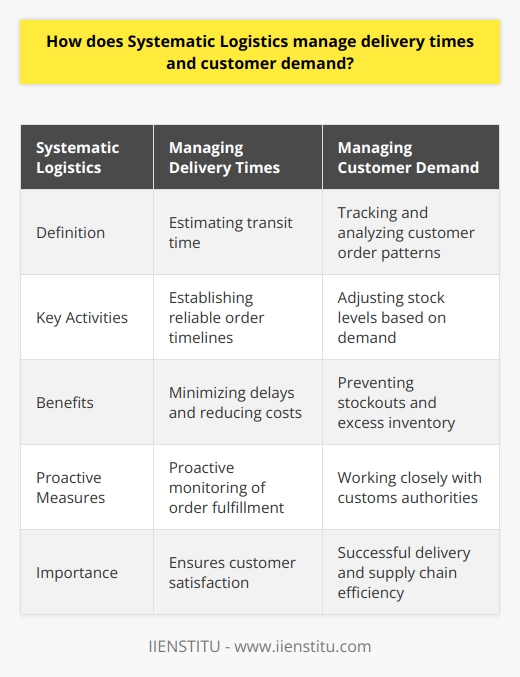
What is the significance of packaging logistics in the supply chain management process?
Significance of Packaging Logistics
Packaging logistics plays a crucial role in the supply chain management process as it directly impacts product protection, transportation efficiency, and overall cost. Successful packaging logistics significantly affects the quality and safety of products as they travel from the producer to the end consumer. Furthermore, optimal packaging designs can reduce material usage and shipping expenses, ultimately contributing to a sustainable supply chain.
Impact on Product Protection and Safety
The primary objective of packaging logistics is to safeguard products during transportation, storage, and handling. High-quality packaging materials and designs are necessary to ensure that products reach consumers in perfect condition. Inadequate packaging can lead to product damage, loss, or decreased product quality, jeopardizing a company's reputation and resulting in financial losses.
Influence on Transportation Efficiency
Packaging logistics also contributes to transportation efficiency by optimizing the use of space and facilitating seamless product handling. Efficient packaging enables companies to transport more products in less space, leading to reduced transportation costs and a smaller carbon footprint. Moreover, well-designed packages can enable faster loading and unloading processes, increasing the overall efficiency of the supply chain.
Cost Reduction and Sustainability
Effective packaging logistics promotes cost savings and environmental sustainability by minimizing material usage and reducing waste. By employing innovative packaging solutions, companies can cut down on production costs and pass those savings onto consumers. Sustainable packaging materials, such as biodegradable or recyclable materials, also lessen the environmental impact of the supply chain by decreasing waste and pollution.
Customization and Consumer Appeal
Lastly, the significance of packaging logistics extends to its influence on consumer perception and marketability. Packaging design can be tailored to specific consumer preferences, demographics or regional requirements, ensuring that products stand out on retail shelves and appeal to target consumers. This customization not only enhances a product's attractiveness but also potentially leads to increased sales and improved brand recognition.
In conclusion, packaging logistics holds immense significance in the supply chain management process as it touches on various aspects such as product protection, transportation efficiency, cost reduction, and consumer appeal. By prioritizing effective packaging strategies, companies can optimize their supply chain performance and ensure long-term success in an increasingly competitive market landscape.
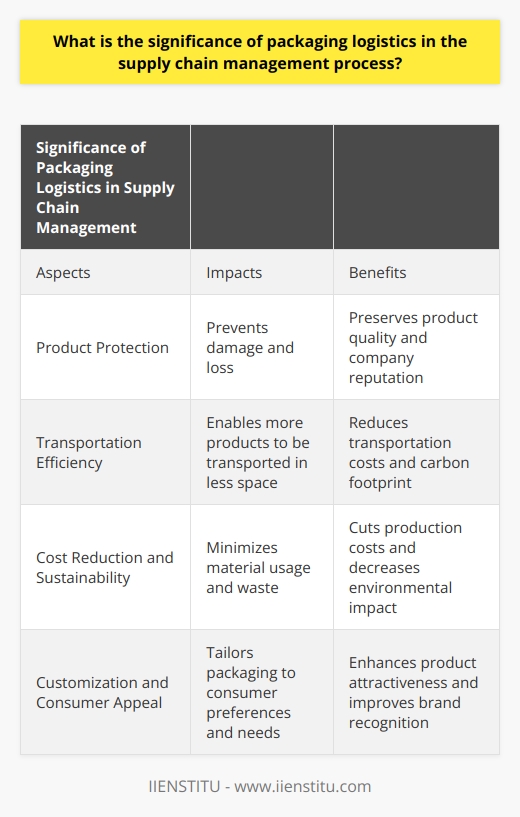
How do environmental concerns and sustainability impact packaging logistics decisions?
Environmental Factors Influencing Packaging Logistics
Environmental concerns and sustainability have become significant factors in shaping packaging logistics decisions in recent years. Companies now consider various aspects, such as material choice, transportation, and waste disposal, to minimize environmental impacts and maintain ecological balance. The evolving awareness and regulations have resulted in multi-faceted approaches to sustainable packaging, making it a crucial part of modern supply chain management.
Materials Selection and Design Approach
When selecting packaging materials, companies prioritize eco-friendly options that can be recycled, reused, or are biodegradable. This commitment leads to innovations such as using plant-based plastics or repurposed materials. Additionally, organizations strive to reduce the volume and weight of packaging materials by optimizing the design, which not only minimizes waste but also lowers transportation costs and emissions associated with shipping.
Transportation and Distribution Strategies
Sustainable packaging logistics decisions also include examining the transportation methods and distribution strategies in place. By consolidating shipments, opting for fuel-efficient cargo vehicles, and employing software for route optimization, organizations can reduce their overall carbon footprint. Furthermore, using local suppliers and adopting a circular economy model can help companies minimize transportation-related environmental impacts while supporting regional economies.
Waste Management and Consumer Education
An essential aspect of sustainable packaging logistics is addressing the end-of-life stage of packaging materials. In response to environmental concerns, companies have started incorporating easily accessible recycling information and infrastructure in their product offerings. They also engage in consumer education programs that encourage proper waste disposal and recycling habits, thereby fostering a more sustainable culture.
In conclusion, it is imperative for companies to consider environmental concerns and sustainability when making packaging logistics decisions. By adopting eco-friendly materials, efficient transportation practices, and promoting responsible waste management, organizations can minimize their environmental impact while meeting the growing demand for sustainable packaging. These actions ultimately contribute to a healthier planet and a more sustainable future for all.
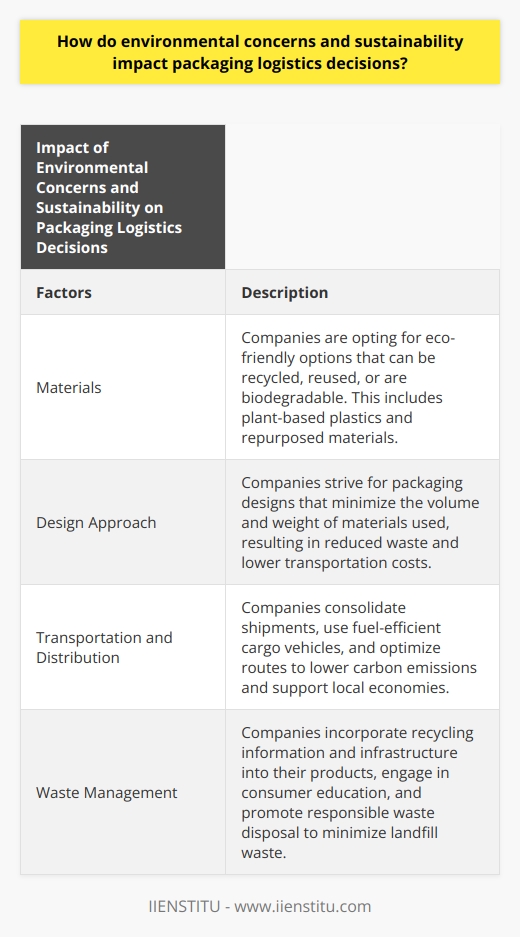
In what ways can technological advancements improve the efficiency and effectiveness of packaging in logistics?
Enhancing Packaging Design
One noteworthy avenue in which technological advancements can augment the efficiency and effectiveness of packaging in logistics is by enhancing packaging design. Utilizing sophisticated software and computer-aided design tools, manufacturers can now create more ergonomic, lightweight, and environment-friendly packaging solutions. A well-designed package not only protects the product during transportation but also optimizes storage space, reducing operational costs for logistics companies.
Innovative Materials and Smart Packaging
Another promising area of progression is the development of innovative materials and the implementation of smart packaging. Advanced materials, such as biodegradable plastics and composites, provide sustainable alternatives to traditional materials without compromising on durability and protection. Moreover, smart packaging can alert handlers of potential tampering, spoilage, or exposure to certain environmental conditions. Such features lead to more secure and effective storage and transportation methods, ultimately benefiting the end-consumer.
Automation and Robotics
Incorporating automation and robotics in the packaging process is another way to improve efficiency and effectiveness. Automated packaging lines and robotic packaging systems can streamline the assembly, sealing, and labeling of packages. These innovations can increase processing speed, reduce the chances of human error, and contribute to a faster and more reliable shipping process for logistics companies.
Reusable Packaging Systems
A critical consideration for modern logistics is reusable packaging systems, which are not only economically viable but also environmentally sustainable. By adopting reusable packaging options, companies can significantly reduce the amount of waste generated, resource consumption, and the overall carbon footprint. Additionally, reusable packaging can enhance the durability of packages, minimizing the risk of product damage and the associated costs.
Improved Tracking and Monitoring
Lastly, technological advancements have made huge strides in improving tracking and monitoring of packages within the logistics chain. By leveraging Internet of Things (IoT) devices, GPS technology, and data analytics, logistics companies can gain real-time insights into package location, condition, and route optimization. This increased transparency and data-driven decision-making can lead to more efficient and effective operations while also enhancing the customer experience.
In conclusion, the integration of innovative designs, materials, automation, reusable systems, and improved tracking can significantly impact the efficiency and effectiveness of packaging in logistics. By embracing such advancements, logistics companies can increase sustainability, reduce costs, and strengthen their competitive advantage within the industry.
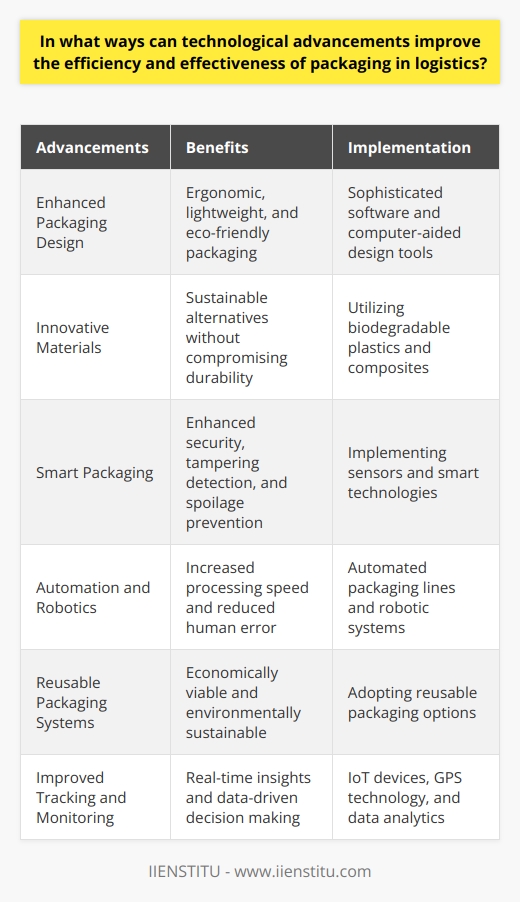
What is the relationship between packaging and logistics?
Role of Packaging in Logistics
The relationship between packaging and logistics is significant as packaging plays a crucial role in the efficient management of the logistics process. Packaging refers to the materials, methods, and techniques used to protect, preserve, and communicate information about a product during transportation, storage, and handling. Logistics, on the other hand, involves the planning, implementation, and control of the flow and storage of goods and related information.
Packaging Influencing Transportation Efficiency
One of the primary functions of packaging is to protect goods during transit, ensuring that they arrive at their final destination undamaged. Packaging materials such as boxes, crates, and pallets determine the stability of products during transportation. The correct choice of package design can prevent damage from mechanical shocks, vibration, moisture, and dust, thus minimizing the cost of product returns and replacements.
Space Utilization and Handling
Providing efficient utilization of space, packaging contributes to the overall effectiveness of logistics operations within a supply chain. Package shapes and sizes can be optimized to maximize storage space in trucks, ships, and warehouses, as well as minimize loading and unloading times. Properly designed packaging also eases the handling process, which results in fewer mistakes and increased productivity among warehouse and transport personnel.
Packaging and Distribution Costs
Packaging decisions impact logistics costs through materials, storage, and transportation expenses. By selecting appropriate packaging materials, businesses can minimize weight and volume, which in turn reduces shipping costs. Packaging that is easy to store and stack reduces warehousing costs, while designs with minimal environmental impact represent compliance with regulations and contribute to a sustainable supply chain.
Information and Communication
Packaging serves as a communication tool in logistics operations. It conveys essential information for accurate inventory management, such as product codes, batch numbers, and expiration dates. This data ultimately affects the overall accuracy and efficiency of the entire logistics process.
In conclusion, packaging and logistics are interdependent, and their relationship is critical to ensure a smooth supply chain. Proper packaging design and materials contribute to the effectiveness of transportation, storage, handling, and communication within logistics operations, ultimately leading to reduced cost and increased customer satisfaction.
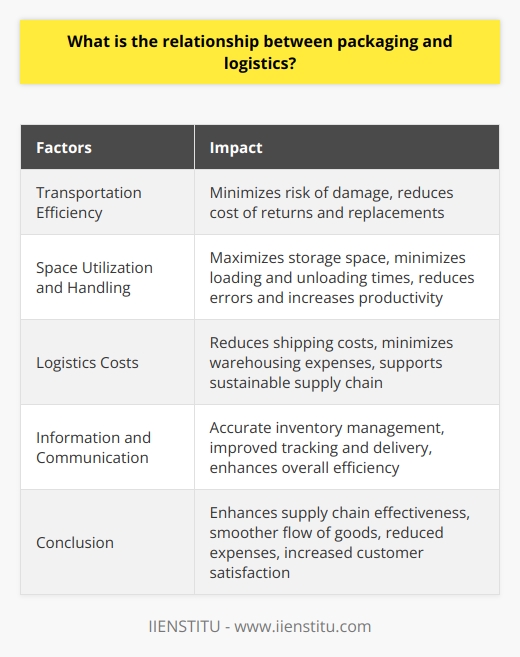
What are the types of packaging in logistics?
Types of Packaging in Logistics
Primary Packaging
Primary packaging is the first layer of protection that directly encases the product. It is the material that comes into direct contact with the item, such as plastic wrapping, bottle, or box. The primary packaging protects the product from environmental factors and ensures product freshness during transportation and storage.
Secondary Packaging
Secondary packaging is an additional layer of protection used to group primary packages together. This facilitates product handling, transportation, and storage. Examples of secondary packaging include cardboard boxes, crates, and shrink films. The secondary packaging may also contain marketing information, such as logos, product descriptions, and directions.
Tertiary Packaging
Tertiary packaging is the most robust layer of protection used to transport bulk quantities of products. It is typically designed for efficient handling and distribution across the supply chain. Examples of tertiary packaging include pallets, shipping containers, and wooden crates. This packaging ensures that the products within are protected from damage during transit and are easy to transport.
Protective Packaging
Protective packaging materials are used to cushion and protect products from shocks, vibrations, and other potential damage during transportation. Common protective packaging materials include bubble wrap, foam inserts, and air pillows, which absorb shocks and ensure products remain undamaged during the shipping process.
Sustainable Packaging
Sustainable packaging is environmentally friendly packaging that minimizes its impact on the environment. It may be made from renewable materials, such as bioplastics, or designed to be reusable or recyclable, reducing waste. Sustainable packaging is a major trend in the logistics industry, as companies strive to reduce their carbon footprint and meet consumer demand for more environmentally responsible products.
Smart Packaging
Smart packaging incorporates technology that adds convenience, security, or interactivity for consumers and logistics providers. Examples of smart packaging include temperature-controlled packaging, RFID tags for tracking products, and interactive packaging that displays information about the product's condition or authenticity. The adoption of smart packaging is growing as companies seek to enhance supply chain efficiency and customer satisfaction.
In summary, there are several types of packaging used in logistics, including primary, secondary, tertiary, protective, sustainable, and smart packaging. Each type serves a specific function in protecting products, promoting environmental sustainability, or improving supply chain efficiency. As the industry evolves, the importance of effective packaging continues to grow, particularly as companies strive to ensure the safety of their products while reducing their environmental impact.
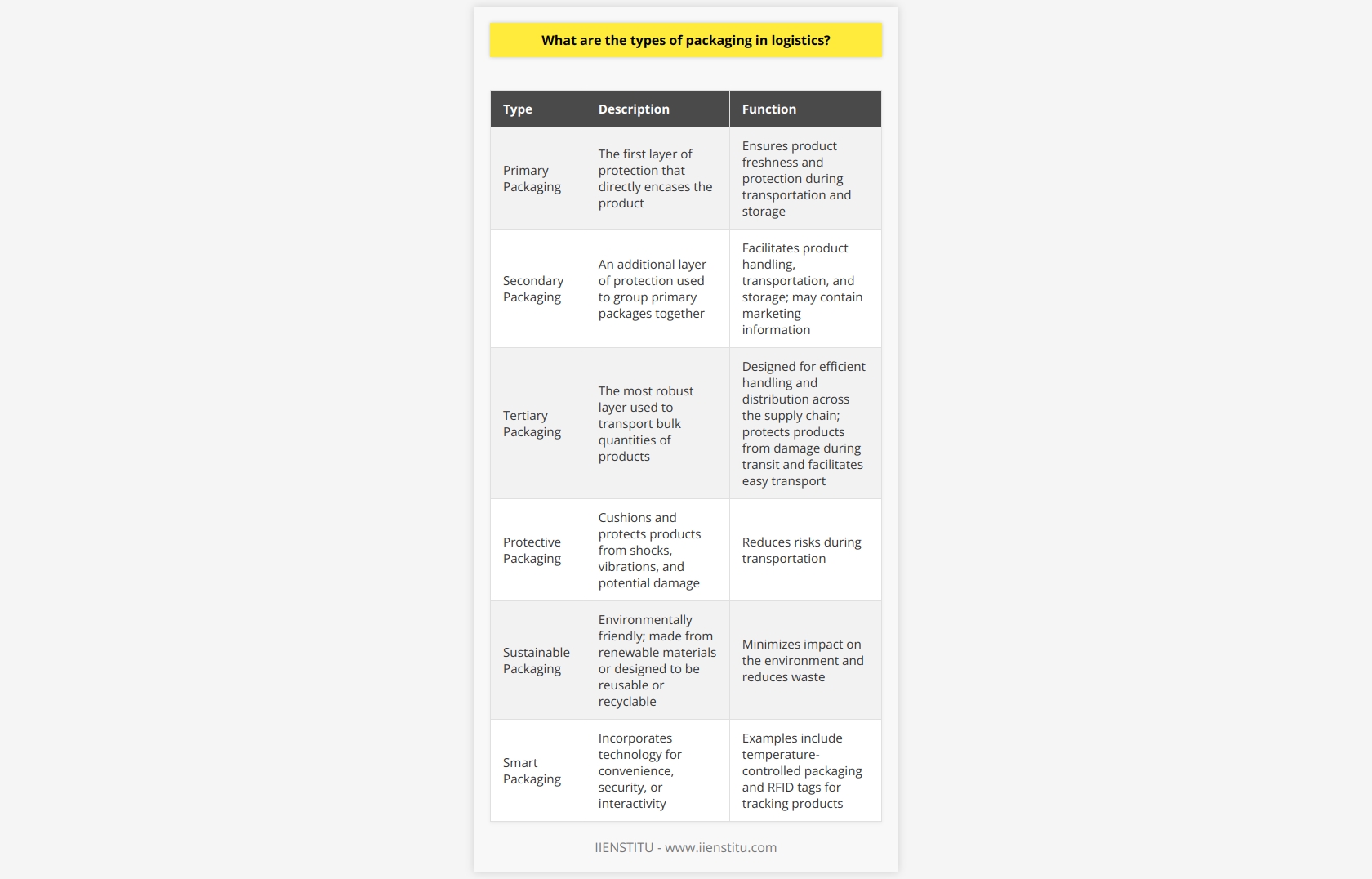
What are the five key objectives of packaging in logistics activities?
Key Objective 1: Protection and Preservation
The primary objective of packaging in logistics is to protect and preserve the product during transportation, handling, and storage. It ensures the product is delivered in its intended condition, reducing damages and spoilage.
Key Objective 2: Containment
Packaging serves as a containment mechanism, holding the product together and preventing contamination. It is crucial for maintaining product integrity, especially for perishable goods and items that require separation from external elements.
Key Objective 3: Information Communication
Information communication is another vital packaging objective. The packaging conveys essential product details such as brand, ingredients, and usage instructions. Additionally, it carries legal and regulatory information like expiration dates and safety warnings.
Key Objective 4: Marketing and Branding
Packaging plays a significant role in marketing and branding activities. Through appealing design and presentation, it can create a strong visual impact that differentiates a product from competitors and influences consumers' purchase decisions.
Key Objective 5: Resource Optimization and Sustainability
Lastly, packaging contributes to resource optimization and sustainability in logistics. By using efficient packaging materials and designs, companies can reduce material usage, transportation costs, and environmental impact. The goal is to achieve a balance between effective packaging and minimal waste generation.
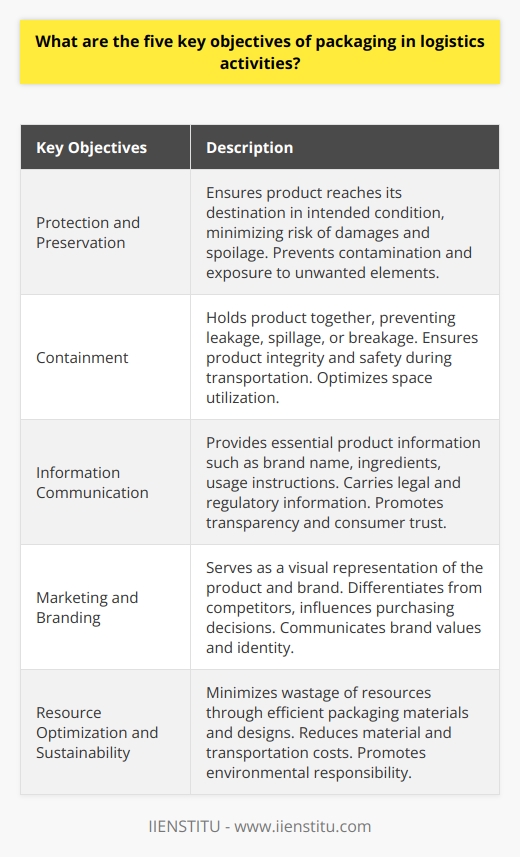
What is the role of packaging logistics in reducing waste and optimizing resource utilization?
Role of Packaging Logistics in Waste Reduction
A critical role in reducing waste and optimizing resource utilization lies within the realm of packaging logistics. Specifically, this refers to the strategic coordination and optimization of packaging materials and processes, aimed at improving sustainability and efficient use of resources.
Innovative Packaging Techniques
Innovative packaging techniques embrace more sustainable materials, such as biodegradable or recyclable options. This helps decrease the environmental impact created by non-degradable waste. Additionally, lighter materials reduce transportation weight, leading to lower carbon emissions and energy consumption.
Efficient Package Design
Efficient package design allows for the reduction of overall materials utilized as well as waste produced in the packaging process. This can be achieved through downsizing, eliminating unnecessary components, or redesigning packaging to better fit contained products. The result is a reduction in production costs and improvements in resource management.
Packaging Reusability and Recovery
Focusing on packaging that can be easily reused or repurposed, instead of single-use materials, is vital in resource optimization. Furthermore, implementing recovery systems for used packaging materials allows for their appropriate disposal or recycling, minimizing waste and promoting circular economies.
Digitalization and Smart Packaging
Digitalization in packaging logistics enhances communication and collaboration along the supply chain. This enables better forecasting of customer demands and optimized inventory management. Moreover, incorporating smart packaging solutions, such as barcodes or tracking devices, can improve product traceability and prevent spoilage or loss, averting unnecessary waste.
Regulations and Collaboration
Regulatory compliance and cross-sector collaboration are also crucial in waste reduction and resource optimization efforts. Government regulations and policies can incentivize companies to employ environmentally-friendly packaging, while partnerships between sectors can foster knowledge sharing and the implementation of best-practices in sustainable packaging logistics.
In conclusion, the role of packaging logistics in reducing waste and optimizing resource utilization is multifaceted, encompassing material choices, design improvements, reusability, digital advancements, and collaboration efforts. Prioritizing these aspects in packaging logistics operations can lead to significant benefits for both businesses and the environment, promoting a more sustainable future.
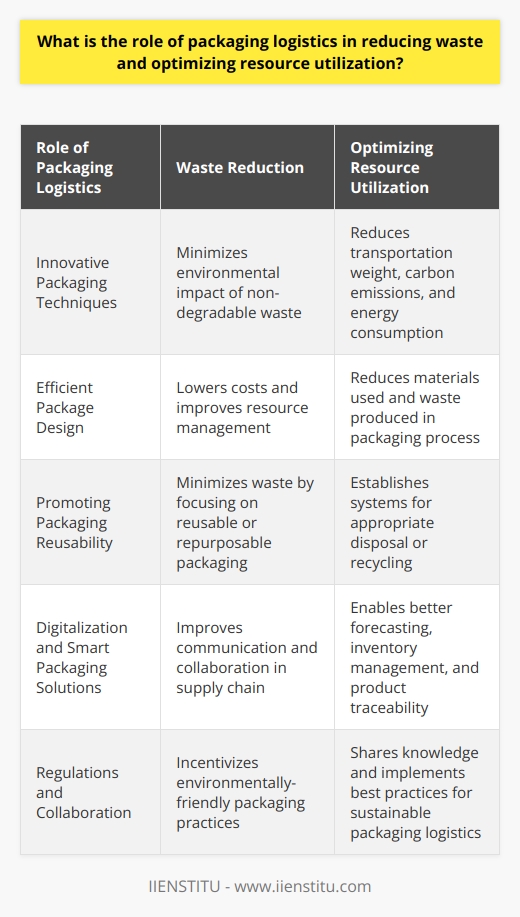
How can the principles of reverse logistics be applied to enhance packaging sustainability?
Applying Reverse Logistics Principles
Packaging sustainability can be significantly improved by utilizing the principles of reverse logistics. To do this, the entire life cycle of packaging materials must be considered, from production to disposal and beyond, including potential reuse or recycling. This holistic approach encourages manufacturers to reduce their environmental footprint, save resources, and minimize waste.
Assessing the Current Situation
The first step involves assessing the current packaging materials and practices, determining their overall effectiveness and identifying areas for potential improvement. It is crucial to examine if materials are easily recyclable, reusable, or compostable. Additionally, assessing the environmental impact of disposal methods can help companies better understand the scope of their packaging sustainability initiatives.
Implementing Resource Recovery
Enhancing packaging sustainability through reverse logistics should focus on recovering valuable materials from used packaging. This could include composting, recycling, or reusing packaging materials in ways that avoid landfill disposal and promote a circular economy. Companies can establish collection points for customers to return used packaging or encourage the use of more eco-friendly alternatives, which can be incorporated back into the production process.
Reducing Waste and Emissions
Applying the principles of reverse logistics can help organizations identify opportunities to reduce packaging waste and emissions. For instance, switching to materials with a lower environmental impact, such as biodegradable, compostable, or recyclable options, will reduce the carbon footprint of packaging. Additionally, consolidating shipments, optimizing transport routes, and maintaining an efficient supply chain can help minimize overall emissions.
Optimizing Processes and Systems
To effectively implement reverse logistics principles, organizations should optimize their processes and systems. This might involve streamlining the return process, maximizing the potential of reusable packaging, and enhancing data collection to track the environmental impact of packaging solutions over time. By leveraging technology, companies can better analyze and optimize their packaging sustainability initiatives, leading to more cost-efficient and eco-friendly outcomes.
Collaboration and Partnerships
Finally, fostering collaboration and partnerships is a critical component of successful reverse logistics initiatives. By working closely with suppliers, distributors, and waste management companies, organizations can improve their overall packaging sustainability by sharing knowledge, resources, and best practices. In doing this, companies can contribute to a more environmentally-friendly future by reducing waste, conserving resources, and strengthening their commitment to a circular economy.
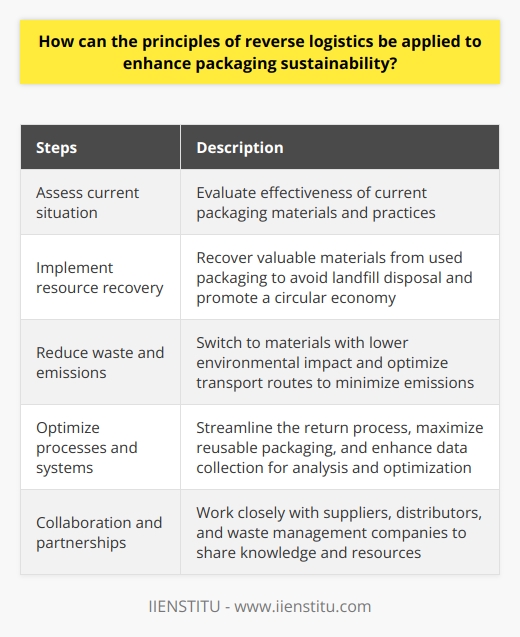
In the context of global supply chains, how do cultural, legal, and regional factors influence the choice and design of packaging in logistics?
Cultural Influences on Packaging Choices
In global supply chains, cultural aspects significantly impact the choice and design of packaging. Specific elements, such as color, symbols, and language, must align with a target market’s preferences and values. For instance, color red predominantly signifies luck and happiness in China, while it can represent danger in Western cultures. Packaging designs should be mindful of these cultural differences to avoid misinterpretations and potential negative implications.
Legal Aspects Shaping Packaging Design
The legal landscape also influences packaging choices across different regions. Compliance with packaging laws and regulations is crucial for businesses to avoid fines, legal disputes, and damage to their brand reputation. Regulations may govern the materials used, the information displayed, and the disposal methods of packaging. One example is the European Union's strict guidelines on the use of recyclable materials, considering the region's commitment to environmental sustainability. Adhering to such legal requirements greatly impacts packaging design and material choices.
Regional Factors Affecting Packaging Decisions
Lastly, regional elements play a vital role in shaping packaging design. Geographical features, such as temperature, humidity, and transportation infrastructure, dictate packaging decisions to ensure the product’s safety and quality throughout its journey. For example, perishable goods transported through tropical climates need packaging that offers ample insulation and air circulation to maintain product integrity. Similarly, regions with poorly developed transportation systems may require more durable packaging materials to withstand potential hazards during transit.
In conclusion, cultural, legal, and regional factors substantially impact the choice and design of packaging in logistics within the context of global supply chains. Navigating the complexities of these elements requires a strong understanding of the target market, adherence to regulations, and a keen awareness of regional challenges. Ultimately, successful packaging strategies account for these factors and effectively balance practicality, compliance, and cultural sensitivity.
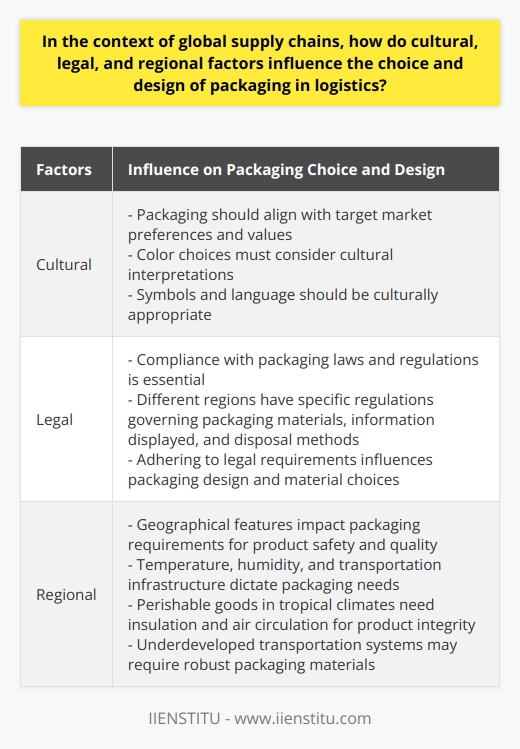
What is the role of packaging design in logistics and supply chain efficiency?
Enhancing Logistics Efficiency Through Packaging Design
Effective packaging design serves a significant function in logistics and supply chain efficiency. It primarily aids in the storage, handling, and transportation of goods. The shape, size, and material of the package play a crucial role.
Goods Protection and Space Optimization
Functional packaging design ensures the protection of products during storage and transit. This lessens the chances of product damage, thereby reducing costs associated with returns and replacements. Additionally, efficient packaging design optimizes space in warehouses and during transportation. Thus, it can substantially reduce storage and shipping costs.
Improving Handling and Transportation
Packaging design also simplifies the processes of loading, unloading, and handling. Practical designs simplify these processes, lowering the risk of accidents. Importantly, easy-to-handle packages can reduce the labor requirement, leading to lesser overhead costs.
Facilitating Product Identification
A well-designed package facilitates product identification and tracking. This, in turn, can accelerate warehousing activities and customer delivery. Packaging design, by aiding in faster and faultless picking, packing, and dispatch operations, enhances overall supply chain velocity.
Promoting Sustainability
Lastly, sustainable packaging design is an emerging trend that can improve the supply chain's sustainability level. Using eco-friendly materials can not only reduce environmental footprints but also, in some cases, bring cost benefits.
In conclusion, packaging design can significantly enhance the efficiency and effectiveness of logistics and supply chain operations. Therefore, businesses need to invest resources in designing efficient packaging that meets functional, cost, and sustainability considerations.
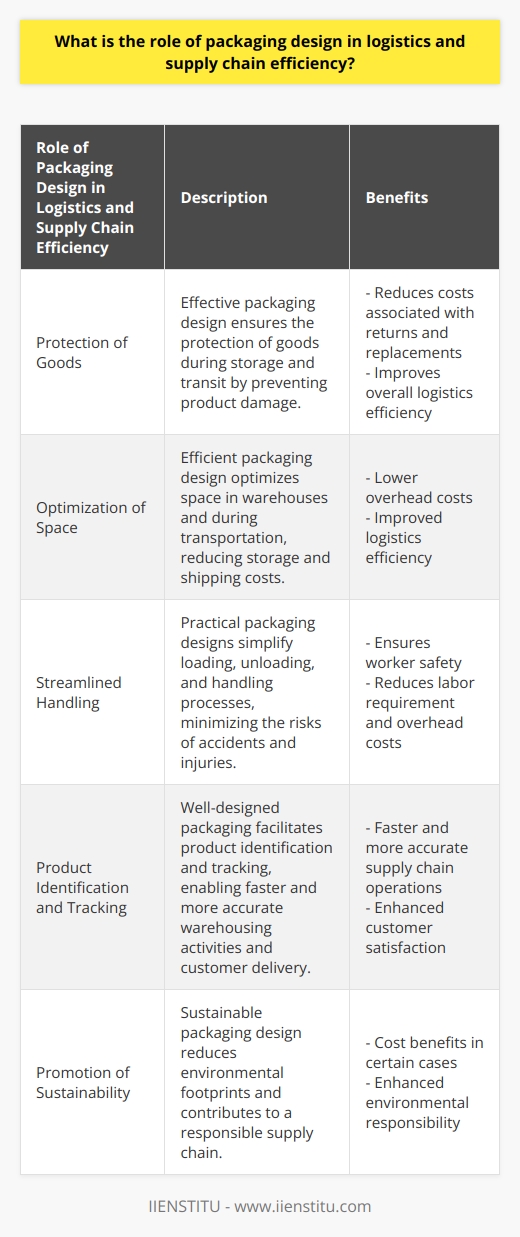
How does packaging logistics contribute to the overall cost and speed of product delivery?
Impact on Cost
Packaging logistics significantly impacts the overall cost of product delivery. Effective packaging cuts down the expense of damaged goods, reducing the need for replacements or refunds. Furthermore, appropriate packaging can optimize space utilization, allowing more products to fit per shipment. This results in lower transportation costs.
Efficiency in Speed
Speed of product delivery also heavily depends on efficient packaging logistics. Strategically planned and executed packaging ensures smoother handling and easier storage. This reduces dwell-time at storage facilities. It also allows quicker loading and unloading of transports, accelerating the transport process.
Sustainable Packaging Choices
The growing trend of eco-friendly packaging also contributes to cost efficiency. Using recyclable material, while being environmentally responsible, can also reduce material costs significantly. Sustainability practices in packaging logistics like minimalism (using less material) further cut down the costs.
Automation and Digitization
Embracing automation also influences cost and speed in product delivery. Automated packaging systems and materials handling equipment can speed up processes and reduce labor-related costs. Digitization, on the other hand, supports efficient tracking and tracing, minimizing errors and delays.
Conclusion
In sum, packaging logistics plays a pivotal role in controlling the cost and ensuring the speed of delivery. It requires balancing various factors like protection, space utilization, sustainability, automation, and digitization. Therefore, effective logistics management can lead to significant savings and efficiency in the overall delivery process.

What are some current trends and innovations in packaging logistics for improving the environmental footprint and resource efficiency of the supply chain?
Innovative Material Selection
One trend is innovative material selection. Companies are exploring eco-friendly materials as alternatives to traditional packaging. A popular choice includes biodegradable packaging that decomposes naturally.
Reusable or Returnable Packaging
Reusable or returnable packaging is another trend. These packages can circulate within the supply chain multiple times, reducing waste generation effectively. It also lowers overall packaging cost, promoting sustainability, and resource efficiency.
Lightweight Packaging
Lightweight packaging is also a rising trend. Reducing the weight of packaging decreases material use and transportation cost, hence reducing carbon emissions. This design improvement impacts both the environment and economic efficiency positively.
Smart Packaging Technologies
Smart packaging technologies have gained traction. These innovations include track and trace technologies that monitor environmental conditions. As a result, this improves logistics efficiency and reduces waste from product spoilage.
Innovations in Packaging Machinery
Equipment transformation is another innovation. New packaging machinery consumes less energy in production, which creates a significant reduction in carbon footprint.
Circular Supply Chain Models
Lastly, circular supply chain models focus on resource efficiency. They aim to close the loop in the supply chain, advocating for waste transformation into new resources. This model emphasises the importance of recycling and recovery of materials.
In conclusion, multiple trends and innovations are transforming packaging logistics. They focus on both improving the environmental footprint while enhancing resource efficiency in supply chains. These solutions offer a promising avenue to a sustainable future.


